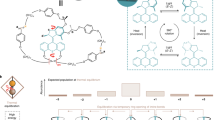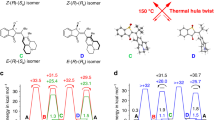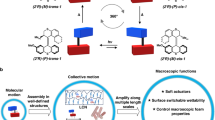Abstract
A current challenge in the field of artificial molecular machines is the synthesis and implementation of systems that can produce useful work when fuelled with a constant source of external energy1,2,3,4,5. The first experimental achievements of this kind consisted of machines with continuous unidirectional rotations6,7,8,9,10,11,12,13,14 and translations15,16,17 that make use of ‘Brownian ratchets’18,19,20,21,22,23,24,25 to bias random motions. An intrinsic limitation of such designs is that an inversion of directionality requires heavy chemical modifications in the structure of the actuating motor part26,27. Here we show that by connecting subunits made of both unidirectional light-driven rotary motors and modulators, which respectively braid and unbraid polymer chains in crosslinked networks, it becomes possible to reverse their integrated motion at all scales. The photostationary state of the system can be tuned by modulation of frequencies using two irradiation wavelengths. Under this out-of-equilibrium condition, the global work output (measured as the contraction or expansion of the material) is controlled by the net flux of clockwise and anticlockwise rotations between the motors and the modulators.
This is a preview of subscription content, access via your institution
Access options
Access Nature and 54 other Nature Portfolio journals
Get Nature+, our best-value online-access subscription
$29.99 / 30 days
cancel any time
Subscribe to this journal
Receive 12 print issues and online access
$259.00 per year
only $21.58 per issue
Buy this article
- Purchase on Springer Link
- Instant access to full article PDF
Prices may be subject to local taxes which are calculated during checkout




Similar content being viewed by others
Change history
24 March 2017
In the original version of this Letter a sentence was mistakenly truncated during production. The correct sentence reads 'The basic concept rests on connecting a nanomotor to a releasing elementary unit (that functions as a clutch) within modules that are functionally robust against thermal noise (and here with polymer chains that function as a transmission). This has been corrected in all versions of the Letter.
References
Abendroth, J. M., Bushuyev, O. S., Weiss, P. S. & Barrett, C. J. Controlling motion at the nanoscale: rise of the molecular machines. ACS Nano 9, 7746–7768 (2015).
Erbas-Cakmak, S., Leigh, D. A., McTernan, C. T. & Nussbaumer, A. L. Artificial molecular machines. Chem. Rev. 115, 10081–10206 (2015).
Coskun, A., Banaszak, M., Astumian, R. D., Stoddart, J. F. & Grzybowski, B. A. Great expectations: can artificial molecular machines deliver on their promise? Chem. Soc. Rev. 41, 19–30 (2012).
Browne, W. R. & Feringa, B. L. Making molecular machines work. Nat. Nanotech. 1, 25–35 (2006).
Kinbara, K. & Aida, T. Toward intelligent molecular machines: directed motions of biological and artificial molecules and assemblies. Chem. Rev. 105, 1377–1400 (2005).
Kistemaker, J. C. M., Štacko, P., Visser, J. & Feringa, B. L. Unidirectional rotary motion in achiral molecular motors. Nat. Chem. 7, 890–896 (2015).
Greb, L., Eichhöfer, A. & Lehn, J.-M. Synthetic molecular motors: thermal N inversion and directional photoinduced C=N bond rotation of camphorquinone imines. Angew. Chem. Int. Ed. 54, 14345–14348 (2015).
Guentner, M. et al. Sunlight-powered kHz rotation of a hemithioindigo-based molecular motor. Nat. Commun. 6, 8406 (2015).
Greb, L. & Lehn, J.-M. Light-driven molecular motors: imines as four-step or two-step unidirectional rotors. J. Am. Chem. Soc. 136, 13114–13117 (2014).
Wang, J. & Feringa, B. L. Dynamic control of chiral space in a catalytic asymmetric reaction using a molecular motor. Science 331, 1429–1432 (2011).
Kudernac, T. et al. Electrically driven directional motion of a four-wheeled molecule on a metal surface. Nature 479, 208–211 (2011).
Klok, M. et al. MHz unidirectional rotation of molecular rotary motors. J. Am. Chem. Soc. 130, 10484–10485 (2008).
Eelkema, R. et al. Molecular machines: nanomotor rotates microscale objects. Nature 440, 163 (2006).
Koumura, N., Zijlstra, R. W. J., van Delden, R. A., Harada, N. & Feringa, B. L. Light-driven monodirectional molecular rotor. Nature 401, 152–155 (1999).
Ragazzon, G., Baroncini, M., Silvi, S., Venturi, M. & Credi, A. Light-powered autonomous and directional molecular motion of a dissipative self-assembling system. Nat. Nanotech. 10, 70–75 (2015).
Cheng, C. et al. An artificial molecular pump. Nat. Nanotech. 10, 547–553 (2015).
Balzani, V. et al. Autonomous artificial nanomotor powered by sunlight. Proc. Natl Acad. Sci. USA 103, 1178–1183 (2006).
Cheng, C., McGonigal, P. R., Stoddart, J. F. & Astumian, R. D. Design and synthesis of nonequilibrium systems. ACS Nano 9, 8672–8688 (2015).
Astumian, R. D. Microscopic reversibility as the organizing principle of molecular machines. Nat. Nanotech. 7, 684–688 (2012).
Serreli, V., Lee, C.-F., Kay, E. R. & Leigh, D. A. A molecular information ratchet. Nature 445, 523–527 (2007).
Astumian, R. D. Design principles for Brownian molecular machines: how to swim in molasses and walk in a hurricane. Phys. Chem. Chem. Phys. 9, 5067–5083 (2007).
Chatterjee, M. N., Kay, E. R. & Leigh, D. A. Beyond switches: ratcheting a particle energetically uphill with a compartmentalized molecular machine. J. Am. Chem. Soc. 128, 4058–4073 (2006).
Mahadevan, L. Motility powered by supramolecular springs and ratchets. Science 288, 95–99 (2000).
Astumian, R. D. Thermodynamics and kinetics of a Brownian motor. Science 276, 917–922 (1997).
Peskin, C. S., Odell, G. M. & Oster, G. F. Cellular motions and thermal fluctuations: the Brownian ratchet. Biophys. J. 65, 316–324 (1993).
Ruangsupapichat, N., Pollard, M. M., Harutyunyan, S. R. & Feringa, B. L. Reversing the direction in a light-driven rotary molecular motor. Nat. Chem. 3, 53–60 (2011).
Fletcher, S. P., Dumur, F., Pollard, M. M. & Feringa, B. L. A reversible, unidirectional molecular rotary motor driven by chemical energy. Science 310, 80–82 (2005).
Li, Q. et al. Macroscopic contraction of a gel induced by the integrated motion of light-driven molecular motors. Nat. Nanotech. 10, 161–165 (2015).
Irie, M., Fukaminato, T., Matsuda, K. & Kobatake, S. Photochromism of diarylethene molecules and crystals: memories, switches, and actuators. Chem. Rev. 114, 12174–12277 (2014).
Maughan, D. W. & Godt, R. E. A quantitative analysis of elastic, entropic, electrostatic, and osmotic forces within relaxed skinned muscle fibers. Biophys. Struct. Mech. 7, 17–40 (1980).
Boekhoven, J., Hendriksen, W. E., Koper, G. J. M., Eelkema, R. & van Esch, J. H. Transient assembly of active materials fueled by a chemical reaction. Science 349, 1075–1079 (2015).
Grzybowski, B. A. & Huck, W. T. S. The nanotechnology of life-inspired systems. Nat. Nanotech. 11, 585–592 (2016).
Acknowledgements
The research leading to these results has received funding from the European Research Council (ERC) under the European Community's Seventh Framework Program (FP7/2007-2013)/ERC Starting Grant agreement no. 257099 (N.G.). We thank the French National Research Agency (ANR, project INTEGRATIONS) for financial support. We also thank the Centre National de la Recherche Scientifique, European Cooperation in Science and Technology action (CM 1304), the International Center for Frontier Research in Chemistry, the Laboratory of Excellence for Complex System Chemistry, the University of Strasbourg and the Institut Universitaire de France. Q.L. thanks the China Scholarship Council for a doctoral fellowship. We are grateful to G. Strub for manufacturing the moulds to shape the gels, J. Lemoine for HPLC purifications and J.-M. Strub for high-resolution mass spectroscopy. The authors also thank V. Le Houerou for discussions.
Author information
Authors and Affiliations
Contributions
G.F., E.M. and N.G. conceived the work. J.T.F., Q.L., A.G., J.-R.C.-I. and D.D. performed the experiments. O.S. established the mathematical model. All the authors discussed and interpreted the data. N.G. wrote the paper and all the authors commented on the manuscript.
Corresponding author
Ethics declarations
Competing interests
The authors declare no competing financial interests.
Supplementary information
Supplementary information
Supplementary information (PDF 1426 kb)
Rights and permissions
About this article
Cite this article
Foy, J., Li, Q., Goujon, A. et al. Dual-light control of nanomachines that integrate motor and modulator subunits. Nature Nanotech 12, 540–545 (2017). https://doi.org/10.1038/nnano.2017.28
Received:
Accepted:
Published:
Issue Date:
DOI: https://doi.org/10.1038/nnano.2017.28
This article is cited by
-
Photo-responsive functional materials based on light-driven molecular motors
Light: Science & Applications (2024)
-
Collective Molecular Machines: Multidimensionality and Reconfigurability
Nano-Micro Letters (2024)
-
A photochemical method to evidence directional molecular motions
Nature Communications (2023)
-
Visible light-induced switching of soft matter materials properties based on thioindigo photoswitches
Nature Communications (2023)
-
Kinetic and energetic insights into the dissipative non-equilibrium operation of an autonomous light-powered supramolecular pump
Nature Nanotechnology (2022)



